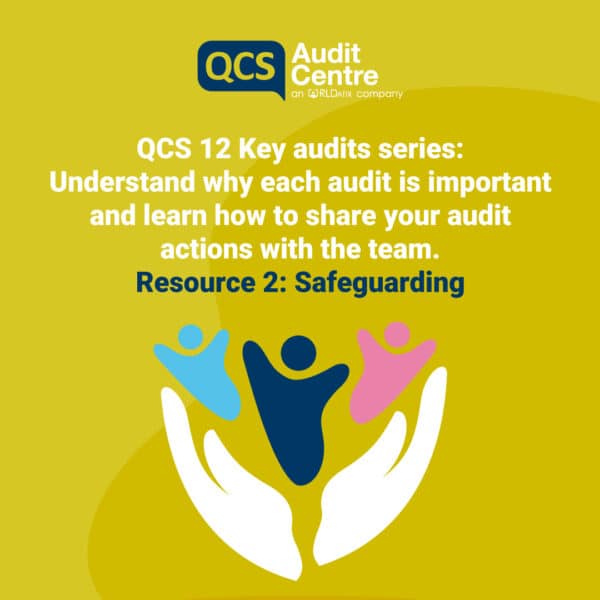Why do we need to complete audits?
To achieve good governance in your service you must demonstrate continuous quality improvement. To do this, auditing and documenting the effectiveness of the processes and systems you have in place, and taking time to observe and document how people experience your service, is essential.
Audits and completed action plans offer evidence of the great care you provide. Where improvements are needed, they allow you to demonstrate openly and clearly how you plan to make the changes required that you have identified.
Safeguarding: the case for auditing
The auditing of all safeguarding activity is a clear way that you can monitor, review and identify themes and areas of concern in relation to abuse and other activity that may have resulted in a safeguarding referral.
However, safeguarding audits will provide you with much more than that. They show people and organisations with an interest in your service, such as the regulator and the local authority, that you are open, transparent, focused on improvement and identifying why, where, when and how safeguarding referrals have been made.
A good quality audit will also help you identify recurring issues and help you to prevent activity that may result in safeguarding. It will ensure that issues are identified and addressed at an earlier stage before escalation into a potentially abusive situation that necessitates a safeguarding referral.
An audit will potentially show what may have been ‘hidden’ themes in any safeguarding incidents, these themes may be things such as the time of day, location, people involved, staff on duty, medication etc. If the audit helps you identify themes it will potentially prevent further safeguarding activity and protect the safety of the people using your service more effectively.
An audit is also a great way for you to ensure that you have done everything that you need to do with every potential safeguarding incident. For example: Did you make a referral to the local authority? Did you complete a notification to the CQC? Did you contact the police if it was required? Did you keep families informed? What actions were taken to protect the safety of people?
The results of the audit may lead on to the further development of risk assessments, care plans, monitoring activity etc. As such, what you might feel is a ‘paper exercise’ can result in improved outcomes for people and can encourage and support staff to deliver high quality care and support.
A safeguarding audit may also be used to identify where additional training is needed for staff, especially if the audit identified issues with how safeguarding was identified or reported.
In social care it is becoming more and more important that information is shared to evidence good practice and the analysis of the results of a safeguarding audit is a good way of showing that you are open, transparent and do not work in a ‘closed environment’. But, as always you need to ensure that any information that is shared is treated confidentially and does not breach any UK GDPR requirement.
As you can see, safeguarding gets to the heart of care, and its importance is vital to understanding the quality of your service. An audit of safeguarding activity is a central process for you to evidence to yourselves, and others, that you are taking the safety of the people you support seriously.
Safeguarding audit: achieving compliance
Audits enable you to provide valid, up to date evidence to the CQC that you are managing the safeguarding process effectively and meeting the required regulations such as:
- Regulation 12: Safe care and treatment
- Regulation 13: Safeguarding service users from abuse and improper treatment
- Regulation 17: Good governance
- Regulation 20: Duty of candour
Findings: what does the safeguarding audit tell you?
Example 1:
An audit revealed that notifications had not always been made to the CQC as required.
As a provider you should:
- Review all notifications made to the CQC, and confirm that they have been completed as required in other areas
- Retrospectively submit the notification to the CQC. It is better to admit to a mistake than to risk that it will not be noticed by the regulator
- Provide further training to relevant staff on the need for notifications and the process to follow
- Provide further training on safeguarding, focusing on the need for transparency and reporting
Example 2:
An audit revealed actions from a safeguarding referral hadn’t been completed as required:
As a provider you should:
- Review all actions and confirm that they have all been allocated to a person for completion
- Establish regular monitoring of action plans, and follow up on missed timescales
- Consider additional safeguarding training for staff
So, what happens next?
Effective auditing can encourage providers and staff to have confidence in your processes and in turn foster an open and transparent culture where staff feel comfortable reporting incidents and near misses, especially if this is part of a no blame culture.
But it does not stop once the audit is complete. Your good governance systems then take over creating an environment where learning and improvement thrive, benefiting the safety and well-being of those receiving care and support.
Once you have had the chance to review your audits you can then if needed:
- Allocate resources
- Implement prevention measures
- Increase/implement/refresh staff training
- Consider environmental changes
- Consider the use of assistive devices
- Share the findings and actions with the team
Now help your team learn about safeguarding audits by completing our QCS Resource 2: Safeguarding Audit: Group Learning Exercise.



